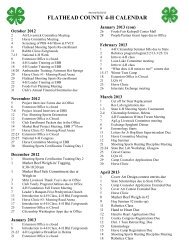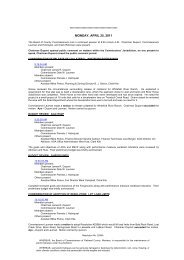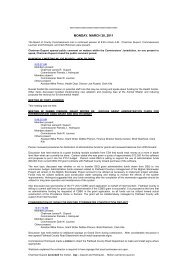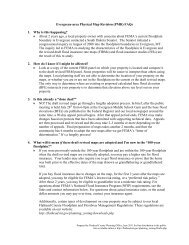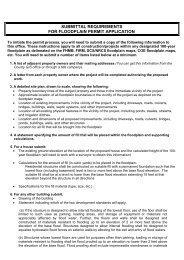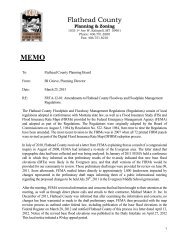MONDAY, MARCH 1, 2010 - Flathead County, Montana
MONDAY, MARCH 1, 2010 - Flathead County, Montana
MONDAY, MARCH 1, 2010 - Flathead County, Montana
Create successful ePaper yourself
Turn your PDF publications into a flip-book with our unique Google optimized e-Paper software.
<strong>MONDAY</strong>, <strong>MARCH</strong> 1, <strong>2010</strong><br />
(Continued)<br />
This ruling was a veritable invitation to the Commissioners to file their Motion for Summary Judgment, which<br />
is standard practice in such proceedings. As aptly noted by Judge Lympus, there is indeed a compelling record<br />
which supports the Commissioners‟ decision to deny the Subdivision. Here, while the developer has argued that<br />
there is evidence that supports a different result, the legally significant fact is that there is evidence that supports the<br />
Commissioners‟ decision to deny the subdivision. This includes evidence of record submitted by the <strong>Montana</strong><br />
Department of Fish Wildlife and Parks, the United States Fish and Wildlife Service, the technical memorandum<br />
prepared by Geomatrix Consultants on behalf of Citizens for a Better <strong>Flathead</strong>, the legal memorandum on north<br />
shore flood easements submitted by attorney Katherine Maxwell, and detailed comments submitted by numerous<br />
organizations and individuals including the <strong>Flathead</strong> Lakers and Citizens for a Better <strong>Flathead</strong>. As required by<br />
Section 76-3-620, M.C.A., the Commissioners sent a detailed statement of the reasons for their denial to the<br />
developer in a letter dated April 25, 2008, along with Findings of Fact dated April 23, 2008, which were filed in the<br />
lawsuit at the request of Judge Lympus, and which Judge Lympus determined “established that a significant bases<br />
for denying the development request” existed in this case.<br />
Moreover, even if the Commissioners had not adequately articulated the bases to their decision to deny the<br />
proposed Subdivision, 2 then the appropriate remedy for the reviewing court would be to remand the matter back to<br />
the governing body to articulate the bases to its decision. See, e.g., Heffernan, et al. v. Missoula City Council, Cause<br />
No. DV-08-84, Order of August 10, 2009, remanding challenged subdivision back to City Council for issuance of<br />
findings of fact as mandated by § 76-3-608(2), MCA; and Kiely Construction, supra, 11-12, explaining that the<br />
District Court declined to grant relief in the form of a “deemed approval” of the subdivision application as sought by<br />
the developer, and instead ordered the governing body to complete the review of the subdivision application in<br />
conformance with the requirements of the Subdivision Act and Subdivision Regulations in effect at the time that the<br />
application was submitted.<br />
The Kiely case is instructive on several other points as well. As a corollary of the rule that the legality of the<br />
governing body‟s decision to approve or disapprove a subdivision must be based upon the court‟s review of the<br />
record, the Kiely Court ruled:<br />
Nor were the after-the-fact opinions of individual counsel members asked the reasons for the denial relevant. In an<br />
analogous situation, courts will not consider post enactment statements of legislatures because they are not<br />
part of the legislative history and accordingly, not part of the record.<br />
Therefore, we conclude it was not error for the trial court to exclude testimony from the individual<br />
counsel members as to their reasons for denying Kiely’s preliminary application, since such testimony<br />
would constitute “post-decision” statements which were not properly part of the record.<br />
Kiley, 97 (citations omitted; emphasis added).<br />
Also in Kiely, the Supreme Court affirmed the District Court‟s approval of the preliminary plat application that<br />
had been denied by the City of Red Lodge, after the subdivision application had been remanded by the District Court<br />
to the local governing body and the local governing body had ignored the remand instructions of the District Court.<br />
Thus, the Supreme Court held:<br />
We conclude the District Court‟s remedy in this case-ordering conditional approval of Kiely‟s<br />
preliminary plat application subject to the original eighteen conditions recommended by the <strong>County</strong><br />
Planning Board-was a proper remedy, and an appropriate response to the unique factual situation<br />
with which the court was presented. In fashioning this remedy, the court noted that “the evidence<br />
was clear that [Kiely] was entitled to the approval,” and recognized that, „[i]n view of the City Council‟s<br />
disregard of the laws of our state in acting upon [Kiely‟s] [preliminary plat] application, there is no<br />
reason to expect that it would follow those laws if the court were to … remand the matter back<br />
to the City Council.”<br />
Kiely, 76 (emphasis added; brackets in original).<br />
Here, in contrast to Kiely, the District Court has already recognized that the record indicates that the<br />
developer is not entitled to the approval. Moreover, had Judge Lympus been presented with motions for substantive<br />
rulings as was done in the cases against the City of Missoula and the City of Red Lodge, and had the Court found<br />
that there were deficiencies in the review of the developer‟s application, then at that point the case would have<br />
appropriately been remanded to the Board of Commissioners to review the application under appropriate legal<br />
standards. However, this proposed settlement, reached in a settlement conference far removed from the public eye,<br />
short-circuits the legitimate judicial process that would not only have allowed the District Court to scrutinize the merits<br />
of the respective parties‟ positions, but would have enabled the public to scrutinize the process.<br />
The Kiely decision is further instructive in the Supreme Court‟s rejection of the developer‟s claims brought<br />
against the local governing body for violation of 42 U.S.C. § 1983. As noted by the Kiely Court:<br />
In order to state a viable § 1983 claim, the plaintiff must first establish it possesses a protected interest<br />
since the guarantees of the Fifth and Fourteenth Amendments “apply only when a constitutionally<br />
protected liberty interest or property interest is at stake.”<br />
Kiely, 23 (citations omitted).<br />
The Kiely Court noted the legislative discretion that the governing body had: “Red Lodge had the<br />
discretionary power to reject/accept the recommendations of the <strong>County</strong> Planning Board, as the jurisdiction for<br />
ultimate approval of the proposed subdivision rested with Red Lodge.” Kiely, 37.<br />
After reviewing the statutory provisions in the Subdivision and Platting Act, the Kiely Court then held:<br />
Thus, we conclude Kiely did not have a protected property interest at the preliminary approval<br />
stage of his plat application process.<br />
* * *




